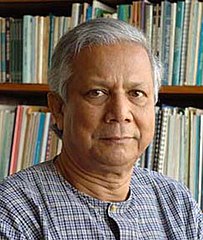Supporting Entrepreneurship in the Developing World: Microfinance in the US
In recent years microfinance organizations have become a popular way for US Americans to support entrepreneurship and small businesses in the developing world. I first learned about the concept a few years ago from a friend who showed me the website kiva.org. At the time I was a student on a limited budget—making small investments in entrepreneurs around the world was very appealing. I read the borrower’s stories, learn about the work they do in their local communities, and get an idea of how they plan to grow their businesses. Microfinance enables me to help small business owners and see the tangible results of my investments. Furthermore, since the money is loaned, it is periodically returned and can be lent out to other borrowers. I believe that, when framed by strict ethical guidelines and done with the intention of alleviating poverty (as opposed to making returns on investments), microfinance has the capability to inspire entrepreneurs and support economies.
![Loan Officer, Small Enterprise Foundation. By GiveWell (GiveWell) [CC-BY-3.0 (www.creativecommons.org/licenses/by/3.0)], via Wikimedia Commons Loan Officer, Small Enterprise Foundation. By GiveWell (GiveWell) [CC-BY-3.0 (www.creativecommons.org/licenses/by/3.0)], via Wikimedia Commons](http://upload.wikimedia.org/wikipedia/commons/thumb/b/b3/Small_Enterprise_Foundation_-_loan_officer.jpg/640px-Small_Enterprise_Foundation_-_loan_officer.jpg)
Loan Officer, Small Enterprise Foundation. By GiveWell (GiveWell) [CC-BY-3.0 (www.creativecommons.org/licenses/by/3.0)], via Wikimedia Commons
What is microfinance?
Microfinance organizations link lenders and borrowers in a more direct way than was previously available. Lenders are able to evaluate their investments as well as the profiles of the borrowers and determine where they will invest their money. Likewise, borrowers are given opportunities to get startup money and additional capital more easily through microfinance institutions than through banks, which they often do not have access to.
Some microfinance organizations use the technique of crowdfunding—where many individuals contribute amounts of money to fund a project. Other organizations offer 1:1 lending.
Financing microloans is a means for creating/sustaining employment opportunities. It supports entrepreneurs and innovative business ideas and as small businesses grow can support the community through creating new job openings.
Microfinance is a means for socially responsible investors to help entrepreneurs grow their businesses.

Microfinance Meeting, Small Enterprise Foundation. By GiveWell (GiveWell) [CC-BY-3.0 (www.creativecommons.org/licenses/by/3.0) via Wikimedia Commons
What are some examples of microfinance organizations?
Some of the popular microfinance organizations in the US are mentioned below. A quick internet search on microfinance organizations will connect you to thousands of additional organizations.
One popular example of an online platform for microfinance is Kiva. This San Francisco-based nonprofit works as an umbrella organization, assembling the funds from its users and distributing them to different microfinance organizations around the world. Kiva rates the credibility of their “field partners” (microfinance partners on the ground) and gives users detailed information about the repayment term, repayment schedule, as well as the organization’s relationship with Kiva.
Kiva brings the profiles of loan recipients directly to the lender, so that they can see the plans for how the loaned money will be applied and background information on the borrower. The minimum loan is $25—a relatively low barrier to entry. Users can loan up to $500 in one loan, and most loans are supported by several users, which distributes the financial risk among the investors. When loans are repaid, users have the option to reinvest or withdraw their money. Kiva’s clean, attractive user face and low initial investment cost make it appealing to a broad variety of investors and do-gooders. (For more detailed information and a video of how Kiva works, see their website.)
Microfinance opportunities are not limited to businesses and entrepreneurs abroad; Opportunity Fund aims to fill the need for microfinance in the US. They write:
“The United States has a market for microfinance. The Aspen Institute estimates that only 2% of potential U.S. microfinance customers are being served compared to the 17% being served in the developing world. Furthermore, a growing percentage of Americans are “unbanked” — 30% of Americans have no banking relationship whatsoever.”
Although their investors loan more individually than Kiva lenders (According to the site,“[m]ore than 90% of our loans are between $1,000 and $10,00”), US businesses tend to need more startup capital than businesses abroad.
Another popular microfinance organization is Prosper. Prosper promotes peer-to-peer lending, where individuals can request and fulfill loans through the website itself (as opposed to through a microfinance organization).
Microfinance Meeting in Kerala, India. By Jaimoen87 (Own work) [CC-BY-SA-3.0 (www.creativecommons.org/licenses/by-sa/3.0) via Wikimedia Commons
Current State of Microfinance
As microfinance becomes more popular, the process has come under more media attention and scrutiny. Problems uncovered include: for-profit microfinance organizations putting undue pressure on borrowers, high interest rates, and corrupt microfinance institutions. Perhaps the most well-known recent incident that shed negative light on microfinance institutions happened in 2010 with the for-profit organization SKS Microfinance. High rate of suicide in the South Indian state Andhra Pradesh, where there was a low level of repayment of microloans. It is unclear whether the organization pressured borrowers to repay loans or if the borrowers themselves felt a great responsibility to repayment. While this situation is being investigated, it shows how important it is to educate borrowers and regulate the operations and tactics of microfinance organizations.
Mohammad Yunus, 2006 Nobel Peace Prize winner, has taken the stance that the field is developing, and not necessarily in positive ways. He writes,
“There are always people eager to take advantage of the vulnerable. But credit programs that seek to profit from the suffering of the poor should not be described as “microcredit,” and investors who own such programs should not be allowed to benefit from the trust and respect that microcredit banks have rightly earned.”
Mohammad Yunus, 2006 Nobel Peace Prize Winner. By Muhammad Yunus (Tanveer Islam, personal Collection) [CC-BY-3.0 (www.creativecommons.org/licenses/by/3.0) via Wikimedia Commons
For more information on issues in the microfinance sector, see David Roodman’s recent book Due Diligence: And Impertinent Inquiry into Microfinance.
Additional Resources:
TED Talk by Nobel Peace Prize Winner Muhammed Yunus on the History of Microfinance
Infographic on Crowdfunding and Microfinance


